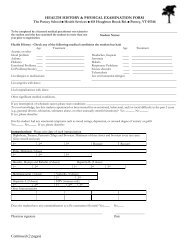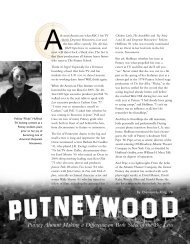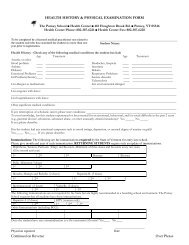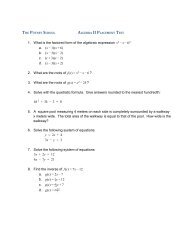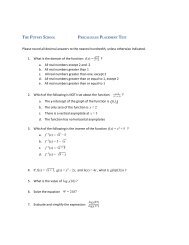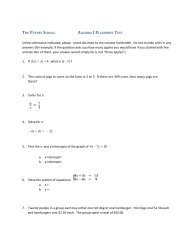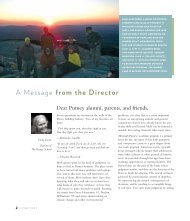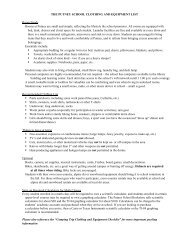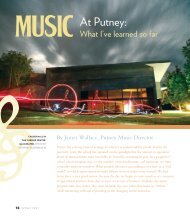The Most Incredible Athlete You Have Ever Met - The Putney School
The Most Incredible Athlete You Have Ever Met - The Putney School
The Most Incredible Athlete You Have Ever Met - The Putney School
Create successful ePaper yourself
Turn your PDF publications into a flip-book with our unique Google optimized e-Paper software.
<strong>The</strong> <strong>Most</strong> <strong>Incredible</strong><br />
<strong>Athlete</strong> <strong>You</strong> <strong>Have</strong><br />
<strong>Ever</strong> <strong>Met</strong><br />
By Natalie Silver ’12<br />
24 <strong>Putney</strong> post
“I love to share the joy you can derive from<br />
exercising. Just from moving your body. It<br />
doesn’t have to be for anything in particular,<br />
other than that perfect selfish moment you use<br />
to take care of yourself. It’s a fantastic feeling<br />
when people just let themselves feel that. <strong>The</strong>y<br />
don’t resist it; they just absorb it.”<br />
—Michael Chevalier<br />
Michael Chevalier laughs as I gasp for air at the end of<br />
my sprints. “That . . . was hard,” I manage to squeeze<br />
out. “Right!? Isn’t it awesome?” he says with a big<br />
smile. His laughter isn’t malicious; he is genuinely<br />
pleased that I have found this difficult. But pleased in<br />
the “I’m proud of you” way. “I think I need a break,”<br />
I say, finally standing up. I am recovering from a cold<br />
and the constant nasal pressure is making the already<br />
difficult suicide sprints feel like death. “Yes of course.<br />
No demerits,” he says. That is classic Michael Chevalier.<br />
He will push you and push you and make you feel<br />
great about what you have accomplished, but it’s all<br />
in the context of your own personal ability. If you are<br />
feeling like it’s too much, “no demerits” for taking it<br />
down a notch.<br />
Michael is different from any coach I have ever had.<br />
With the others it was always expected that you would<br />
meet their standard, not your own. If you were injured,<br />
play through it. Sick? Too bad. <strong>You</strong> could ride the bench<br />
if you could withstand the palpable judgment that<br />
would undoubtedly be passed about your character. But<br />
Michael isn’t like that. He wants everyone he trains to<br />
feel joy from exercise and—more importantly—to feel<br />
joy from pushing their bodies to the limit. He has made<br />
me less afraid of my own limitations and helped me<br />
accept them and get joy from reaching them. In a world<br />
based on competition, Michael Chevalier has taught me<br />
how to relax and enjoy whatever sport it is I am doing.<br />
I put my foot next to the first cone and nod to let him<br />
know I am ready for the next set of sprints.<br />
“Alright sister. Go for it.”<br />
<strong>Most</strong> people at <strong>The</strong> <strong>Putney</strong> <strong>School</strong>, where Michael is a<br />
nurse and the athletic trainer, see him as only that. But<br />
Michael, like so many superheroes, is far more than he<br />
appears in everyday life. Michael is the most incredible<br />
athlete you have never met.<br />
Michael was born in 1966, in Goshen,<br />
Massachusetts, one of nine children.<br />
He began to play baseball at age six and was<br />
immediately made a pitcher. “My friends<br />
and I played every sport imaginable” Michael<br />
tells me, but baseball was his passion.<br />
“It was just what you did. It didn’t feel weird to<br />
stand on the mound and have people staring at<br />
me. It felt natural.”<br />
Michael turns from side to side in his swivel chair<br />
as we sit in his office. <strong>The</strong>re is something pure<br />
about him—not naïve, however. No, because you<br />
can tell he has felt pain and happiness and sadness<br />
and has generally lived life fully. Once you have<br />
met him, you know he is remarkable. Not only<br />
as an athlete, but also as a human. <strong>The</strong> sense of<br />
purity I feel from him is rare.<br />
“<strong>The</strong> high school I went to was competitive,<br />
so it became a big deal that I made varsity as a<br />
freshman,” Michael tells me.<br />
“I had a few hits in my first few games. I didn’t<br />
really think about the pressure. I just did what I<br />
do. <strong>The</strong> ball is coming, you see it, you hit it.” He<br />
says with a laugh. As we continue to talk about<br />
his high school years, every story has the same<br />
matter-of-fact air. He did what he did. He was<br />
<strong>Incredible</strong><br />
[Ed. note: Natalie Silver ’12,<br />
(pictured) now in her first<br />
year at Bates College, wrote<br />
this profile of <strong>Putney</strong> health<br />
office staff member and athletic<br />
trainer, Michael Chevalier, as<br />
part of her Senior Exhibition<br />
on sports journalism<br />
last spring.]<br />
<strong>Ever</strong>yone<br />
who frequents the<br />
field house after<br />
3 p.m. knows Michael<br />
Chevalier is our<br />
athletic trainer,<br />
But Did you know<br />
he was once a semi-<br />
professional <strong>Athlete</strong>?<br />
<strong>Putney</strong> post 25
<strong>Athlete</strong><br />
<strong>Incredible</strong><br />
the<br />
During home games,<br />
Michael is the go-to<br />
guy for both teams<br />
wHEN it comes to firstline<br />
medical attention.<br />
star of his baseball team, but he never told me<br />
that. I knew. Michael would never say he was the<br />
best because he doesn’t think that way.<br />
In that competitive environment, a freshman on<br />
the varsity baseball team created a lot of buzz,<br />
and a fair amount of press. When Michael was<br />
a junior, major league scouts started to show up<br />
at his games. Even though he was getting this<br />
attention, Michael was not drafted right out of<br />
high school. “Apparently, I wasn’t draft material,”<br />
says Michael, in that same matter-of-fact manner.<br />
“I always struggled academically. <strong>School</strong> was<br />
always a challenge . . . sports were my outlet. <strong>The</strong>y<br />
were my confidence.” Michael knew, even then,<br />
that exercise was his key to sleeping better and<br />
enjoying peace of mind.<br />
When Michael got out of high school, he<br />
continued to play baseball, at first in a summer<br />
league, and after three years, he was picked up<br />
to play on a semi-pro team. Michael was 21.<br />
<strong>The</strong> semi-pro team had a long summer schedule<br />
and Michael was pitching almost every night of<br />
the week. When he talks about the guys on the<br />
team, his face beams as he remembers the beers<br />
they drank after games and the trash they talked<br />
during practice.<br />
Minor league scouts were always showing up at<br />
semi-pro games. But that third summer they were<br />
again showing up for Michael. When I asked him<br />
if he ever got nervous, he shook his head. “Not<br />
really. If I thought about it I guess I would, but<br />
when I was on the field they weren’t part of the<br />
equation. <strong>The</strong>y weren’t one of my teammates.<br />
My teammates were it. I didn’t care about<br />
anything else. <strong>The</strong> team was everything to me.”<br />
Michael was approached by a man from the<br />
Pittsfield <strong>Met</strong>s, the AA development team for<br />
the New York <strong>Met</strong>s. “ I told him this is what I<br />
was always aiming to do. I wasn’t good enough to<br />
be drafted. I was what was called a roster filler. But I<br />
didn’t care. I just wanted to play.” So Michael went<br />
to show the team his stuff. “It was one of those<br />
times that all the stars aligned. When I went and<br />
pitched for them, the game felt so easy.” Michael<br />
signed with the team for the next season.<br />
“I had a good year. I was throwing well. And<br />
the next year was better. My stats kept getting<br />
better, and I started to wonder, are they going to<br />
move me up to AAA? AAA is in eyesight of the<br />
big leagues. And I was very excited about that.”<br />
Michael was working hard and it showed. But<br />
the “next step” conversations weren’t happening.<br />
Michael stands at about 5 feet 9. He was by far<br />
the smallest guy, but he was also throwing harder<br />
than all of them, around 92 mph. “<strong>The</strong>y [major<br />
league scouts and managers] thought, and it was<br />
true, that smaller guys used so much more energy<br />
pitching than big guys.” In order to compensate<br />
for the energy he was expending, he trained<br />
outside of the team practice time. “My teammates<br />
used to always laugh at that. ‘He just will not tire,<br />
you could put him out there after 12 innings<br />
and he’d still be throwing just as hard.’ And I<br />
prided myself on that. I was proving to them<br />
that I wouldn’t break down, and that their size<br />
argument didn’t work.”<br />
But it did in the end. “<strong>The</strong>y told me I definitely<br />
had the stuff to be in ‘the show,’ but that major<br />
league teams wouldn’t give me the chance. That<br />
was hard. I was 25, and by that time it’s too late to<br />
start over. If you don’t get signed with someone<br />
by then, it’s time to stop.” So here you have<br />
Michael Chevalier, who threw harder, trained<br />
harder, and loved the game, but it didn’t matter.<br />
<strong>The</strong>re was no pain in his voice when he talked<br />
about it. No regret.<br />
But as a young athlete on the road to professional<br />
sports, hearing that there was no future for<br />
him in the game he loved was devastating.<br />
Who was he without being a baseball player?<br />
He struggled with this sudden redefinition of his<br />
life. Michael continued playing baseball in his<br />
old semi-pro league, for the love of the game.<br />
Something else became evident as the dream<br />
of professional baseball faded away: that feeling of<br />
release and happiness after exercise. “At first I did<br />
want to become a better athlete. But what really<br />
happened was that I fell in love with the way I<br />
felt afterwards. That sense of calm, that clarity.”<br />
With this new chapter, he found that being a<br />
professional athlete wasn’t as important<br />
or meaningful as the peace of mind and sense<br />
of calm he got from being fit and exercising.<br />
26 <strong>Putney</strong> post
“To me it is very meditative. And that’s what<br />
really pulls me in. If I’m feeling distracted or if<br />
the workout feels harder than I know it should,<br />
I know there is something more going on inside<br />
me—that is the resistance I’m meeting. Once I<br />
start, I can analyze that resistance on some levels,<br />
maybe not coming up with an answer, but I<br />
can push that stress out of my body. <strong>The</strong> sweat<br />
that comes out is the stress exiting my body.”<br />
Michael’s mood always improved after a workout,<br />
and he could focus at work. Exercise always had<br />
been essential to his life, but now he was very<br />
aware of it.<br />
In his late 20s, Michael entered nursing school<br />
and became a trainer at the local gym. His selfconditioning,<br />
combined with years of sports and a<br />
nursing degree, made him incredibly well-versed in<br />
how the body works, and how to train it. He taught<br />
spin classes, did personal training, and more. Michael<br />
also continued his own training.<br />
<strong>The</strong>se days, one of his preferred events is tower<br />
runs. <strong>The</strong>se races take place in some of the tallest<br />
buildings in the country. <strong>The</strong>y are stair races.<br />
This past winter, Michael ran the Empire State<br />
Building race. He came in 26th—out of 3,000.<br />
One of Michael’s favorite training tools for these<br />
races is the ski jump in Brattleboro, Vermont,<br />
where he now lives. <strong>The</strong> ski jump is only 300<br />
stairs, he says, so he runs it about eight or nine<br />
times. Eight or nine times?? Only 300 stairs? <strong>The</strong><br />
man is a beast.<br />
In the late 1980s, when Michael was training<br />
the U.S. crew team at a gym in northern<br />
Massachusetts, he devised terrible, terrible<br />
workouts in an attempt to tire these superathletes.<br />
I decided I wanted to try one of these<br />
workouts to see what the hype was about.<br />
I start out with a 15-pound bar across my shoulders.<br />
<strong>The</strong> progression goes like this: upright rows, overhead<br />
press, bench press, triceps, biceps. Oh, and with 15<br />
squats in between each. Do that seven times and see<br />
how you feel. Typical Michael just stands by and<br />
laughs as my breath gets shorter and I glare at him<br />
for convincing me to do this workout. As I finish, 25<br />
minutes later, he says “Hey great job. Next time we<br />
can add weight!”<br />
A<strong>The</strong> Gym Rats: Exercising for Academics<br />
A group of students at <strong>The</strong> <strong>Putney</strong> <strong>School</strong> have dubbed themselves the “Gym Rats”<br />
because they are taking part in an experiment to see if periodic exercise throughout the<br />
day helps them with their school work. <strong>The</strong> experiment is based on Dr. John Ratey’s<br />
book entitled Spark: <strong>The</strong> Revolutionary New Science of Exercise and the Brain.<br />
“<strong>The</strong> book acknowledges how exercise can work in lieu of medications for conditions<br />
like ADHD, which is the focus of this group, but it also works across the board for<br />
depression, anxiety, and stress,” says Michael Chevalier, who directs the 30-minute<br />
workout sessions at 7 a.m. and 7 p.m., Monday through Friday. Michael is a nurse<br />
who works in the health office, but he also serves as the school’s athletic trainer.<br />
As for motivation to implement the program at <strong>Putney</strong>, swapping, in some cases,<br />
movement for meds, Michael says, “I’ve always been a believer in that and I feel so<br />
strongly about it that I really wanted to jump on board so that students could try<br />
this and see what they think.”<br />
Proposed and funded by a gift from parents of a current student, the regimen<br />
is different from traditional physical education classes and afternoon sports and<br />
activities. It’s a specific set of exercises designed to not only elevate participants’<br />
heart rates for thirty minutes, but to also stimulate the brain to focus by way of<br />
specific drills such as dribbling a basketball with the “wrong” hand, jumping rope,<br />
and other specific movements. Ideally, the program would meet three times per<br />
day—at 7 a.m., 1 p.m., and 7 p.m.—but that just wouldn’t fit into <strong>Putney</strong>’s day because<br />
so many students have jobs that start at 1 p.m. So the initial schedule included a<br />
3 p.m. workout. “It just didn’t make sense,” says Michael, “because there aren’t any<br />
classes at 3:30 p.m.” Michael keeps the routines fresh. Although some movements<br />
and activities will repeat, Michael says, “We’ve done over 100 sessions and no two<br />
have been alike.”<br />
Official student participants receive afternoon activity credit for the Gym Rats,<br />
but plenty of others drop into classes, as do faculty members. After a recent early<br />
morning session, dean of students Tom Kardel said, “When I leave every morning,<br />
I feel like my day has really begun.”<br />
But does it work for the students? <strong>The</strong>re are currently six students officially enrolled,<br />
including three who remain from the beginning of the program last September.<br />
Flannery ’14, a founding member of the Gym Rats, says, “I was on ADHD meds<br />
before this and I went off of them, and this is basically replacing my meds. It’s doing<br />
the positive things my Adderall did, minus feeling sick all the time and socially<br />
weird—the things that go along with ADHD medication.” Michael reports that one<br />
student turned completely around from failing classes to excelling in them—except<br />
for the Gym Rats sessions. He missed enough of them that he didn’t get credit for<br />
the activity. Those of you who fit under the ADHD umbrella can appreciate how<br />
that can happen.<br />
It’s anecdotal evidence, but there’s a sense that something is working and the word is<br />
spreading among students that there’s another tool for managing ADHD. For a look<br />
at one of our sessions search for “<strong>The</strong> <strong>Putney</strong> <strong>School</strong>: Exercising for Academics with<br />
Michael Chevalier” on our <strong>You</strong>Tube page.<br />
<strong>Putney</strong> post 27




